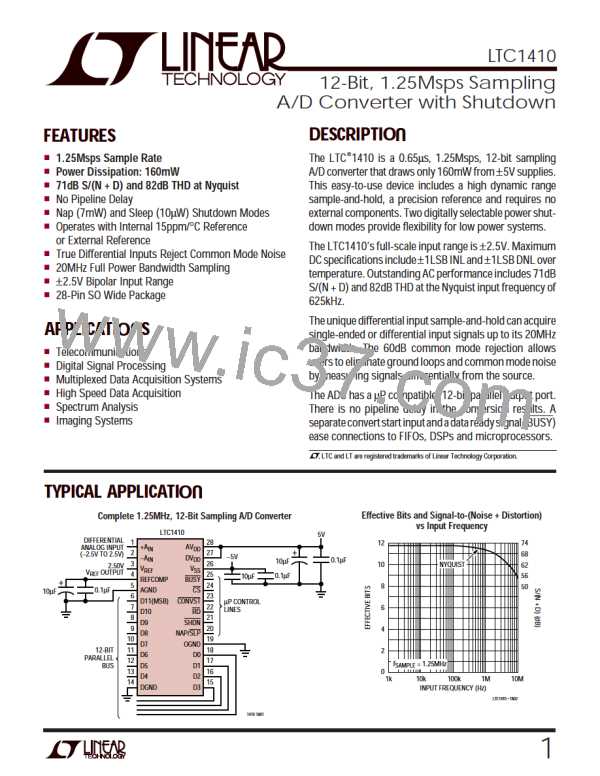LTC1410
U
W U U
APPLICATIONS INFORMATION
0
–20
where V is the RMS amplitude of the fundamental fre-
1
(f ) (f )
f
= 1.25MHz
= 88.19580078kHz
= 111.9995117kHz
a
b
SAMPLE
f
IN1
quency and V through V are the amplitudes of the
2
n
f
IN2
secondthroughnthharmonics.THDvs InputFrequencyis
shown in Figure 4. The LTC1410 has good distortion
performance up to the Nyquist frequency and beyond.
–40
–60
(2f –f )
(2f –f ) (f +f ) (2f +f )
a
b
b
a
a
b
a
b
(2f ) (2f )
(f +2f )
(f –f )
a
b
a
b
b
a
0
–10
–20
–30
–40
–50
–60
(3f )
(3f )
b
–80
a
–100
–120
100
0
200
300
FREQUENCY (MHz)
400
500
600
1410 F05
THD
3RD
–70
–80
Figure 5. Intermodulation Distortion Plot
2ND
–90
Peak Harmonic or Spurious Noise
–100
1k
10k
100k
1M
10M
The peak harmonic or spurious noise is the largest spec-
tral component excluding the input signal and DC. This
value is expressed in decibel relative to the RMS value of
a full-scale input signal.
INPUT FREQUENCY (Hz)
1410 G03
Figure 4. Distortion vs Input Frequency
Full Power and Full Linear Bandwidth
Intermodulation Distortion (IMD)
The full power bandwidth is that input frequency at which
the amplitude of the reconstructed fundamental is re-
duced by 3dB for a full-scale input signal.
If the ADC input signal consists of more than one spectral
component, the ADC transfer function nonlinearity can
produce Intermodulation Distortion in addition to THD.
IMD is the change in one sinusoidal input caused by the
presence of another sinusoidal input at a different
frequency.
The full linear bandwidth is the input frequency at which
the S/(N + D) has dropped to 68dB (11 effective bits). The
LTC1410 has been designed to optimize input bandwidth,
allowing the ADC to undersample input signals with fre-
quencies above the converter’s Nyquist frequency. The
noise floor stays very low at high frequencies; S/(N + D)
does not become dominated by distortion until frequen-
cies far beyond Nyquist.
If two pure sine waves of frequencies fa and fb are applied
to the ADC input, nonlinearities in the ADC transfer func-
tion can create distortion products at the sum and differ-
ence frequencies of mfa ± nfb, where m and n = 0, 1, 2, 3,
etc. For example, the 2nd order IMD terms include
(fa +fb).Ifthetwoinputsinewaves areequalinmagnitude,
the value (in decibels) of the 2nd order IMD products can
be expressed by the following formula:
Driving the Analog Input
The differential analog inputs of the LTC1410 are easy to
drive. The inputs may be driven differentially or as a
single-ended input (i.e., the –A input is grounded). The
IN
Amplitude at f ± f
(
)
a
b
+A and –A inputs are sampled at the same instant.
IN
IN
IMD f + f = 20 log
(
)
a
b
Any unwanted signal that is common mode to both
inputs will be reduced by the common mode rejection of
the sample-and-hold circuit. The inputs draw only one
small current spike while charging the sample-and-hold
Amplitude at fa
9

 Linear [ Linear ]
Linear [ Linear ]